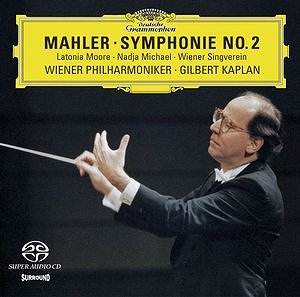Gilbert Kaplan’s obsession with Mahler’s ‘Resurrection’
Symphony has led him to Vienna. Here are his most recent thoughts
on a score in which he has located over 400 received errors in
a performance that uses the critical edition published jointly
by Universal Edition and the Kaplan Foundation. Most of these
corrections will not be immediately aurally obvious on hearing
these discs, but what will be is Kaplan’s tremendous and intimate
knowledge of the score. Minutiae are worshipped and the recording
quality aids and abets this. Crystal clear and revealing the Vienna
orchestra truthfully, this superior sound means that right from
the beginning doublings register clearly with the listener.
The Vienna Philharmonic is in tremendous form,
backing Kaplan’s conception to the hilt. Singing, aching string
lines contribute to the ‘rightness’ this first movement exudes.
Only a couple of points raise question marks. The orchestral ‘crashes’
at 11’59 that interrupt a restatement of the opening gestures
could certainly be more visceral; without recourse to a transcript
of Kaplan’s scholarship is likewise difficult to tell whether
the Luftpausen at around 14’24ff are imperfectly realised
or whether the effect is purposeful. There certainly seems to
be some editing here, as there is a subtle acoustic change …
The standard of playing is superb, of that there
is no doubt and the level of detail to be heard is a model, the
clear recording being part and parcel of this. Despite all this
(possibly because of it?), this is not a movement of awe-inspiring
grandeur of conception and maybe that is Kaplan’s Achilles heel.
He is still on a journey to find his ‘perfect’ realisation, it
would appear, and so this is actually historical musicology in
progress (albeit with the greatest vehicle in the world to practise
it on).
There is a literalism present in the second movement
that lends the music a certain dignity but robs it of any suave
leanings. The third movement avoids any such trap. Quixotic and
elusive, Kaplan here takes us into a shadowy world where bass-lines
creep menacingly. Unfortunately the horn ‘whoops’ (notated whoops,
though) are calculated in their execution, not nightmarish shrieks.
So to the first of the soloists. Nadja Michael
is the tremulous mezzo in ‘Urlicht’, far too much so and this
is especially distracting given Kaplan’s funereal pace. It becomes
in the light of this difficult to resonate with the underlying
meanings of Mahler’s chosen text (from ‘Des Knaben Wunderhorn’).
An over-careful approach is again in evidence
at the very opening of the final movement. True, one can hear
absolutely everything, but it sounds calculated. It is a pity
that the movement starts like this, for it continues very well.
Brass chorales are beautifully warm; ‘Dies irae’ repetitions are
remarkably ominous; off-stage brass is miraculously balanced in
the stereo picture. Yet the downside of the recording is that
some typically DG close-miking can really throw the listener off-balance
(be warned, flutes will whizz at you).
The segue between the dying flute arabesques
and the choral entry (‘Aufersteh’n’) is strange. There is no pause
between the two, no space to let the atmosphere resonate. The
chorus is excellent, though. A pity Kaplan makes Mahler’s orchestral
doublings of the chorus so obvious, as surely they are there to
keep less-than-top-flight choruses in tune? They do sound clumsy,
it has to be admitted.
The final affirmation of ‘Aufersteh’n’ is not
truly climactic, a necessary consequence, possibly, of Kaplan’s
approach, but hardly an apt reaction to Mahler’s fervent religiosity.
This is not the affirmation it should be.
It would be interesting to clarify the markings
on the ‘sfp’s close to the end of the work: are they marked ‘sffp’,
then a ‘mfp’? Bernstein was one to make a huge deal out of these
(memorably), here they just sound literal.
There is much to admire in this reading and the
VPO is a delight from first to last, but ultimately this ‘Resurrection’
does not emerge as the life-enhancing affirmation it can be.
An artist discussion with Kaplan is planned on
the DG website for November 24th, 2003 (see http://www.deutschegrammophon.com/home.htms.).
Questions can be posted between November 13th-21st.
The Kaplan Second is also available on SACD (474 594-2).
Colin Clarke
see also
Gilbert
Kaplan talks to Marc Bridle about Mahler’s Second Symphony.
Concert
review
